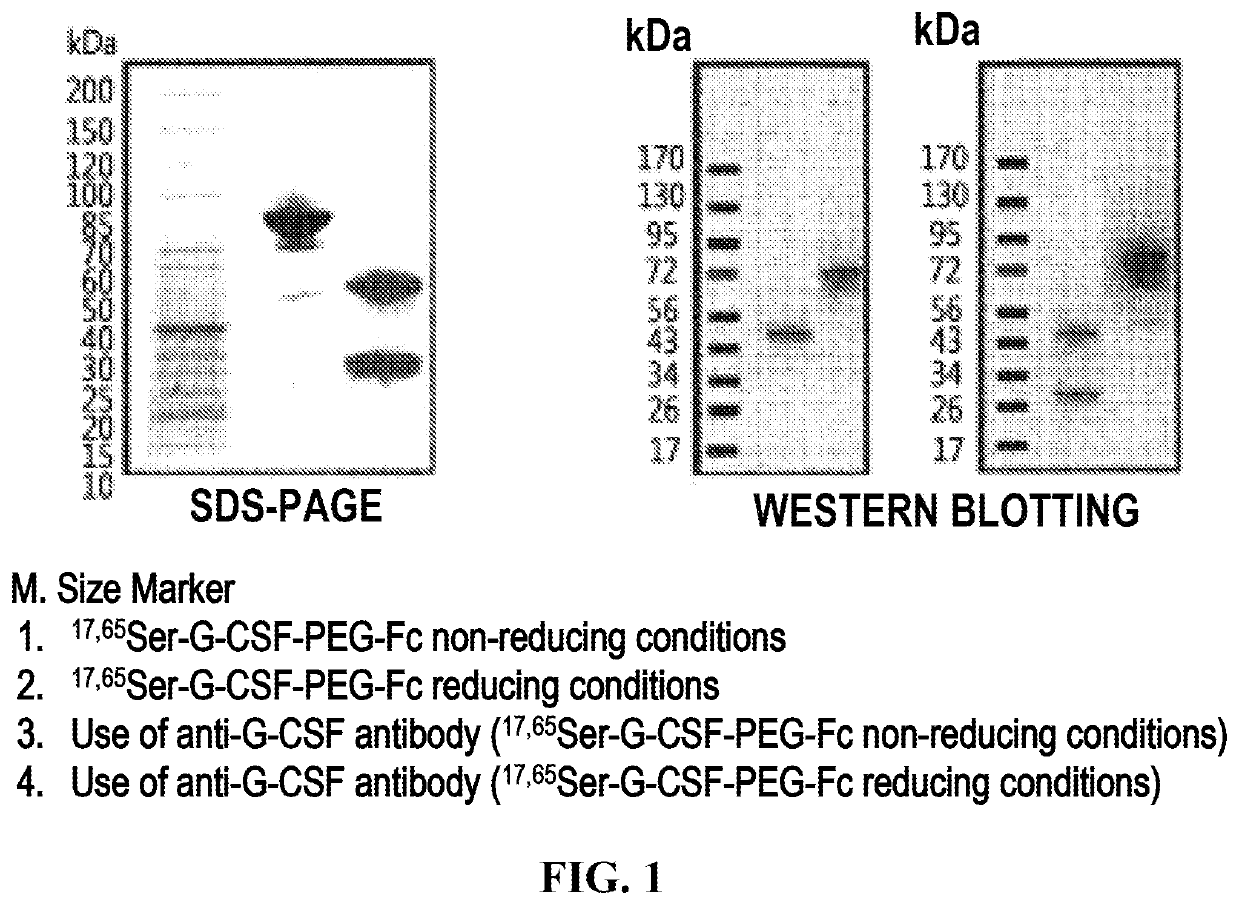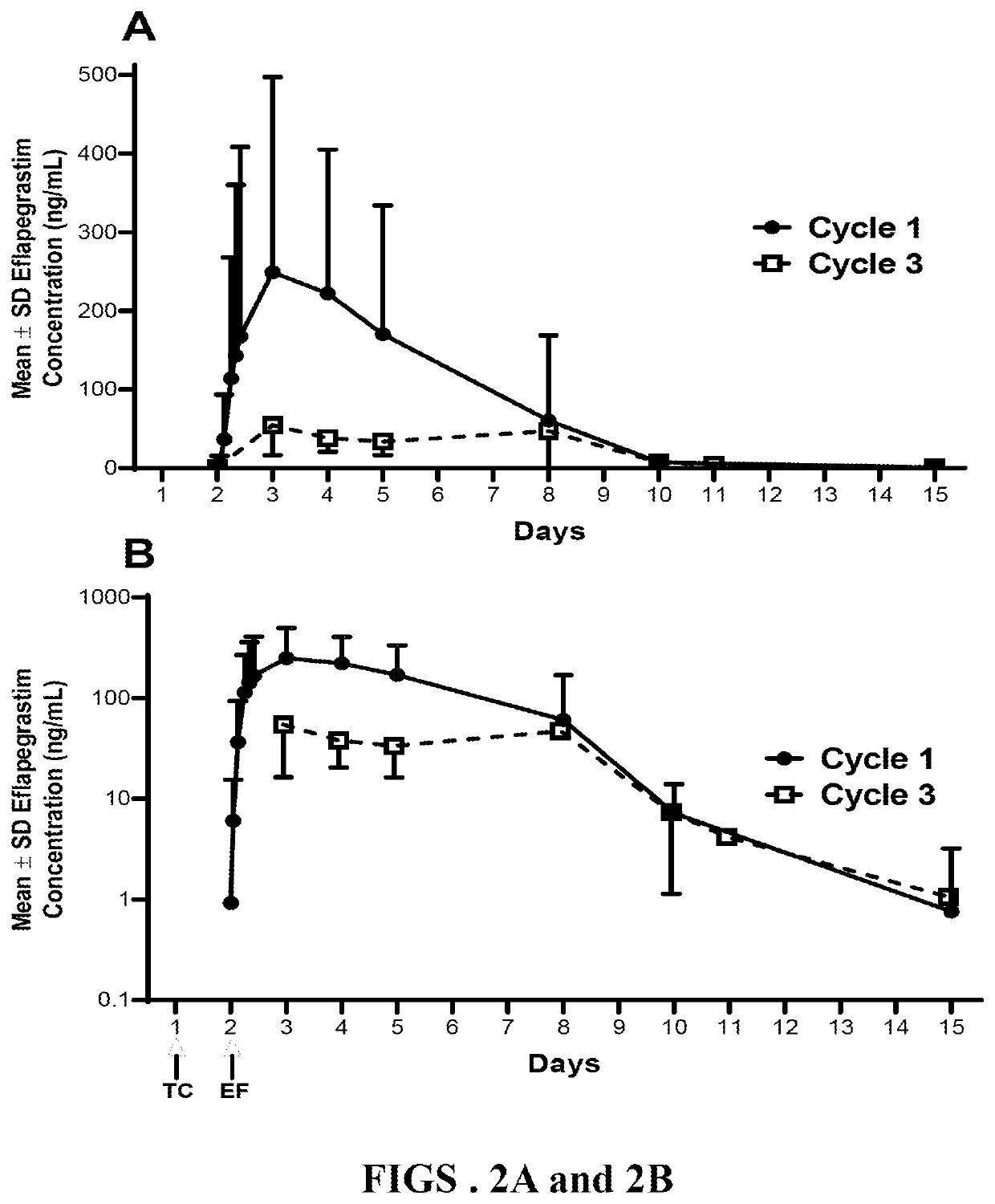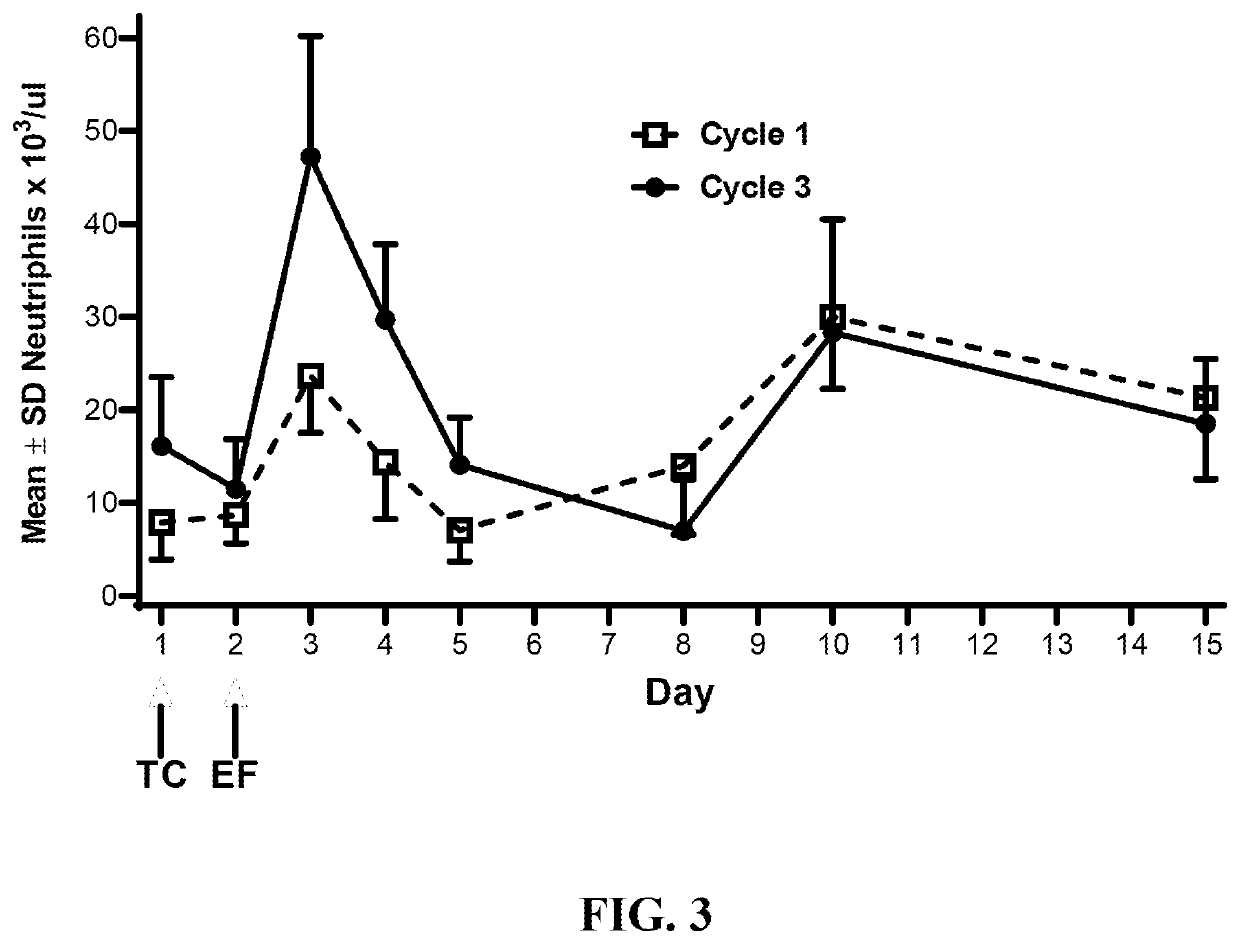Methods of treating chemotherapy induced neutropenia using fixed doses of g-csf protein complex
a technology of gcsf protein and neutropenia, which is applied in the direction of drug composition, peptide/protein ingredients, extracellular fluid disorder, etc., can solve the problems of affecting the early and long-term clinical outcome, affecting the risk of neutropenia, and prolonged hospitalization, so as to reduce the risk of developing neutropenia and achieve optimal therapeutic outcome
- Summary
- Abstract
- Description
- Claims
- Application Information
AI Technical Summary
Benefits of technology
Problems solved by technology
Method used
Image
Examples
example 1
on of Human Granulocyte Colony Stimulating Factor (G-CSF)-PEG-Fc Complex
[0135]The 17,65SG-CSF-PEG-Fc protein complex was prepared using a derivative (17,65-G-CSF) prepared by substituting serine for the amino acids at positions 17 and 65 of the native G-CSF and then purified.
[0136]1-1. Preparation of 17,65SG-CSF-PEG Conjugate
[0137]ALD-PEG-ALD (IDB, Korea), which is polyethylene glycol (PEG) having a molecular weight of 3.4 kDa and aldehyde reactive groups at both ends thereof, was added to 5 mg / mL of 17,65S-G-CSF (molecular weight: 18 kDa) dissolved in 100 mM phosphate buffer at a molar ratio of G-CSF:PEG of 1:5 to 1:10. A reducing agent, sodium cyanoborohydride (NaBH3CN, Sigma), was added thereto at a final concentration of 20 mM and allowed to react at 4° C. to 8° C. under slow stirring for about 1 hour. To obtain a conjugate in which PEG is selectively linked to the amino terminus of human granulocyte colony stimulating factor and PEG and G-CSF are linked to each other at a ratio...
example 2
on of Protein Complex Using PEG with Different Reactive Groups
[0142]2-1. Preparation of 17,65SG-CSF-PEG Conjugate
[0143]SMB-PEG-SMB (Nektar, USA), which is polyethylene glycol (PEG) having a molecular weight of 3.4 kDa and succinimidyl alpha-methyl butanoate (SMB) reactive groups at both ends thereof, was added to 10 mg / mL of 17,65SG-CSF (molecular weight 18 kDa) dissolved in 20 mM phosphate buffer (pH 8.0) at a molar ratio of G-CSF:PEG of 1:3, and allowed to react at room temperature under slow stifling for about 30 minutes. To obtain a conjugate in which PEG is selectively linked to the amino terminus of 17,65SG-CSF and PEG and 17,65SG-CSF are linked to each other at a ratio of 1:1, the reaction mixture was subjected to SP HP (GE Healthcare, USA) cation exchange chromatography.
[0144]2-2. Preparation of 17,65SG-CSF-PEG-Fc Complex
[0145]In order to link the 17,65SG-CSF-PEG conjugate purified in Example 2-1 to a region other than the N-terminus of immunoglobulin Fc, the immunoglobulin ...
example 3
n of Efficacy of Complex Depending on Fc Binding Position
[0148]The protein complexes prepared in Examples above, 17,65SG-CSF-PEG-Fc was subjected to in vitro and in vivo efficacy tests, respectively. As shown in the following Tale, binding to the N-terminus (proline) of Fc showed better efficacy than binding to other regions (e.g., lysine).
TABLE 1In vitro activity-use bone marrow cell proliferation assay of 17,65SG-CSF-PEG-Fc positional isomers% vs. Test materialEC50 (ng / ml)Experimental group17,65SG-CSF-(N-terminus)-PEG-(N-134.43100.00Terminus) Fc-Experimental Group17,65SG-CSF-(N-terminus)-PEG-225.8759.50(lysine) Fc
[0149]As shown in Table 1, comparison of in vitro activities between 17,65SG-CSF-(N-terminus)-PEG-(N-Terminus) Fc-Experimental Group S-G-CSF-PEG-Fc positional isomers showed that the 17,65SG-CSF-(N-terminus)-PEG-(N-Terminus) Fc-Experimental Group S-G-CSF-PEG-Fc complex of the present invention, which was prepared by specific binding to a N-terminus of immunoglobulin Fc fr...
PUM
| Property | Measurement | Unit |
|---|---|---|
| weight | aaaaa | aaaaa |
| volume | aaaaa | aaaaa |
| volume | aaaaa | aaaaa |
Abstract
Description
Claims
Application Information
 Login to View More
Login to View More - R&D
- Intellectual Property
- Life Sciences
- Materials
- Tech Scout
- Unparalleled Data Quality
- Higher Quality Content
- 60% Fewer Hallucinations
Browse by: Latest US Patents, China's latest patents, Technical Efficacy Thesaurus, Application Domain, Technology Topic, Popular Technical Reports.
© 2025 PatSnap. All rights reserved.Legal|Privacy policy|Modern Slavery Act Transparency Statement|Sitemap|About US| Contact US: help@patsnap.com



